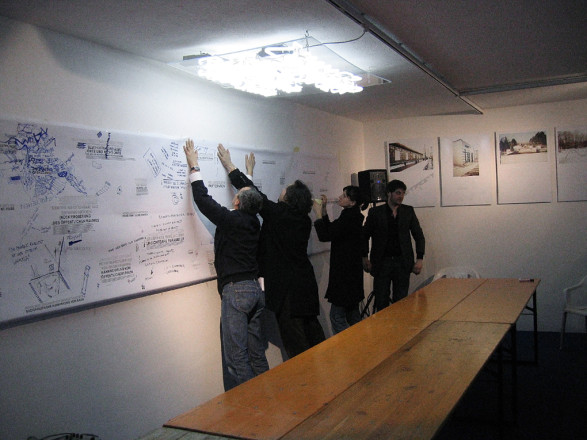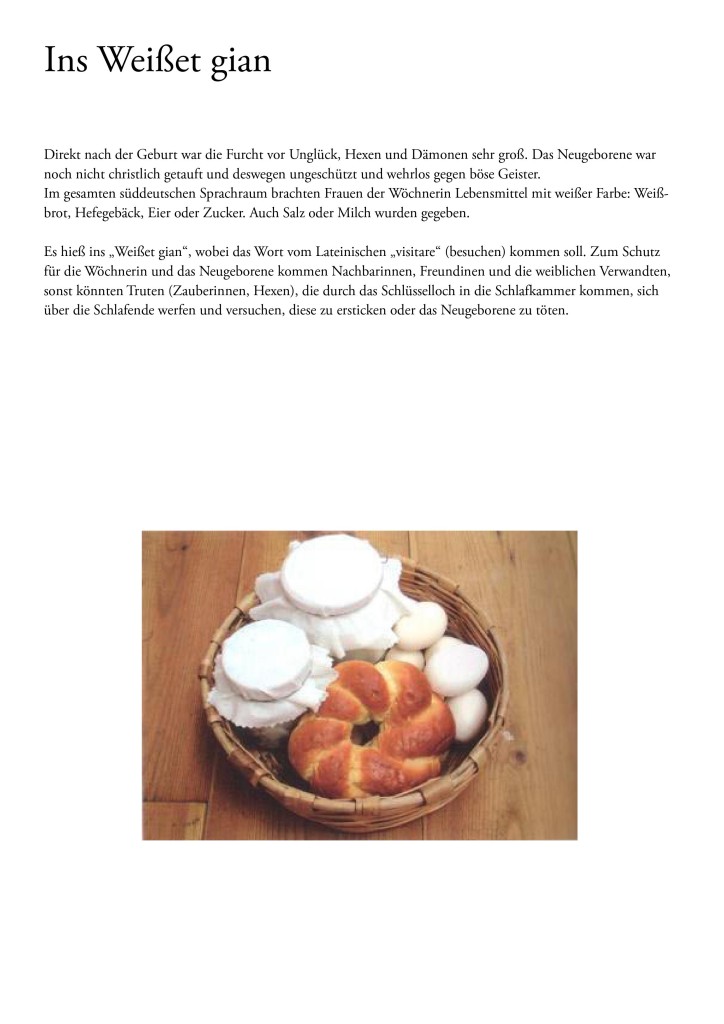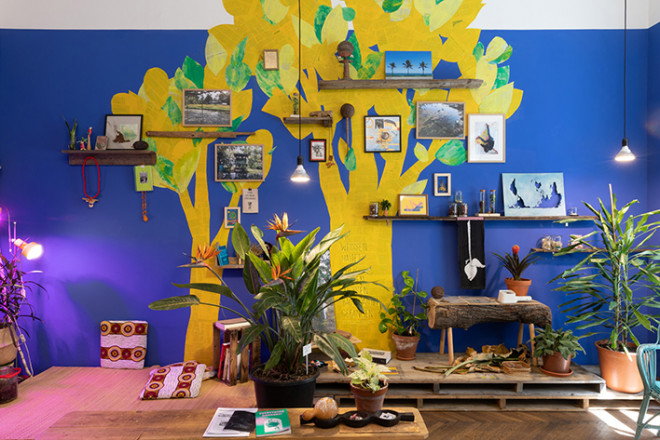translating tradition
Customs and traditions provide us with information on people’s way of life, on the societal and social contexts against which a particular history takes place and a particular setting can be understood; they embody a system of beliefs and a certain image people have of themselves. The way we live, what we eat, drink and wear, the homes in which we dwell, how we celebrate, fragments of our views on life and the world – all of this and more is a component of what is passed down to posterity by a cultural group. The way in which these lifestyles, traditions and customs are carried out and evolve over the years is of course subject to constant change; people in every era attempt to maintain, preserve or develop these customs, or are ultimately forced to relinquish them.
The project “translating tradition” looks at the customs and traditions of the South Tyrol region. These are taken as the point of departure for investigating tradition as a vehicle for nonverbal communication tied to the here and now. A hat in which the color of the band indicates whether the man is married or looking for a bride; a blue farmer’s apron worn on workdays and taken off only at night, at the end of the workday rolled up and tied around the waist – these are two examples of the customs and traditions of this northernmost region of Italy.
“translating tradition” reflects on the customs and traditions of South Tyrol based on a variety of creative forms of expression and positions, analyzes the symbolism and handing down of certain signs, and interprets them anew. South Tyrol with its unique history is the springboard for the project, international designers are its “interpreters”, casting their gaze from the outside onto the societal and social connections coloring the history of this region. This interplay, along with an effort to further develop the potential inherent in nonverbal messages to provide information on the environment in which they arise, is the theme of this project. Every tradition and every custom contains a gesture, and with the help of symbols tells us something about or illustrates an aspect of everyday life and the way people see things. Just as importantly, these customs carry messages to the outside world. Some messages are still valid for us today, while others are outdated and can no longer be related to our present-day lives. And yet they can still form a point of departure for reformulating ideas and concepts and positioning them in time.
The curators have selected 10 customs and traditions from the region of South Tyrol and described their significance – these will form the point of reference for the project. Our contemplations will begin with an exploration of their messages and symbolism, and their potential to function as “communicators”. The results of this examination will be presented in a exhibition at Galerie Lungomare.
A show during the European Biennale Manifesta 7 in South Tyrol/Trentino.
Lungomare
South Tyrol is located in the north of Italy, bordering Austria and Switzerland and has always been a rural region. Aside from the few cities, which had been established commercial centers for centuries, the largest part of the population worked in the farming sector till the mid 1900s. Nowadays the peasant population has become a smaller part of society. For the mountainous territory, with the farm houses being hard to reach and often very far one from the other, old traditions and customs are well-preserved and are still being lived. But the origins are also being cultivated and looked after in the easier accessible parts of the country. e people are proud to show their tradition, eventhough in many cases the derivation is not known.
For the exhibition “translating tradition”, taking place in May 2008 at Lungomare Gallery, traditions from very di erent areas of life have been selected. Some can be matched to a certain valley, others could be found in the whole region, some even in the entire area of the Alps.
The selection was made according to the aspect of communication, each tradition was and still is nowadays a tool to communicate a message. e chosen customs and traditions all mirror matters, which were essential in the past.
They were connected to seeking a job, or to the work on a farm and the resulting relationships. But also private matters such as family status, single or married, and the relationship of the social classes, or the rules between the farmer, the farmer’s wife, the farm hand and the maidservant.
In the area of Merano and the Sarentino Valley the traditional hat is not only a headpiece, but also a communication tool. It symbolizes a man’s family status, whether he is single or married. The headpiece designed by Denise Bonapace uses the communicating side of the hat in a more generalized way. The hat frees thoughts and words, which are caught in the head and visualizes them. The thoughts are told in words by the hat.
__fabrics interseason started from the last remains of the traditional costumes the South Tyrolean man wears: the blue apron. Still today many men wear the apron proudly. It is normal to use the apron not only as protection of clothes, but also to pick apples, as basket for seeding or and the top part for storing the paperwork when going to offcial departments and authorities. This conversion was the conceptual base of transformation of the blue apron by __fabrics interseason.
In the life of farm hands and maidservants personal property was little. But no matter how poor, a spoon was always part of the personal belongings. Max Lamb transported the thought of individual cutlery to material and form and has developed a series of spoons for this exhibition. As in former times, no spoon resembles the other and becomes this way an individual object of utility.
Folding meanings – the messages communicated through gestures using fans, which allowed women in the 19th century to communicate with men secretly without words, were interpreted by Luisa Lorenza Corna creating an apparent meaningless graphic print that reveals messages once folded. A stratification of different phrases lies on the same surface, as the same fan was used to launch a variegate spectrum of signals. The way we use, modify and ‘distort’ objects reveals, intentionally or not, are fragments of speech and wishes.
After the birth of a child, the fear of misfortune, witches and daemons was strong. The newborn baby could not immediately be baptized and was therefore vulnerable, unprotected and defenceless against evil spirits. As protection for mother and baby, female relatives brought white food, such as bread, eggs, sugar, salt, milk or bakery to the house of the young mother. The squirrel by Julia Lohmann and Gero Grundmann carries encoded messages for the baby, combining protection and wishes from family and friends.
In different traditional costumes, the farmer’s wife wears as signs of her status a key, knife or a tool for repairing leather from her belt.These objects serve to de ne her role as the mistress of the farm. The research project began with an interview with women, seeking their personal views on the ‘keys’ they retain and the human values that need ‘repair’ today. A selection of their answers were then translated into different interpretations that aim to capture and manifest the underlying relationship between these women of today, the meaning of power, and the need for dialogue.
Sound piece by Stefano Bernardi on the theme “Ins Weißet gian”
Autonomous Province of Bozen/Bolzano-South Tyrol, Culture Departments
Autonomous Province of Bozen/Bolzano-South Tyrol, Ripartizione Artigianato Industria e Commercio
Tecnomag
EOS-Solutions
Heinrich Gasser
Parkhotel Laurin
What´s on
EXHIBITION :: Binta Diaw :: Collective Practices – A Living Experience of Feeling ListenedAbout Lungomare
Lungomare, a cultural association founded in Bolzano in 2003, was created from the desire and necessity to open a space in which to share differences, experiences, opinions and desires, a space in which to make the link between cultural production and the political and social dimension. Lungomare undertakes projects that investigate and test possible relationships between design, architecture, urban planning, art and theory, the results of which are presented in different formats: public discussions, conferences, publications, exhibitions and interventions in public spaces. All these formats are characterised by the intention to interact with cultural and socio-political processes relating to the region in which Lungomare is located.
Currently Lungomare’s activities focus on long-term residency projects, a format whereby Lungomare invites guests to engage and interact within the context of South Tyrol. Lungomare’s activities are based on three principles: specific attention to the context in which the association’s projects are undertaken, the transdisciplinary approach that distinguishes these projects, and reflection on the role of Lungomare as a cultural institution in connection with the region in which it operates.
Territory
Lungomare is located at the edge of Bolzano, the capital of South Tyrol, and relates to the context in which it operates, attempting to highlight the dynamics of change. Large urbanized areas alternate with broad areas of intensive cultivation and yet others of picturesque landscape, all of which penetrate the centre of the city. The city is surrounded by mountains and this is one of the reasons why the tourism industry has become a driving force in this locality. The demographic structure of the city has been characterized for a long time by the coexistence of two populations, those speaking German and those speaking Italian. However, the social and demographic composition of Alto Adige Südtirol is changing. Migrants, including those from non-European countries are making their way to the area to settle, whilst others, including political refugees, are flowing through the region.





